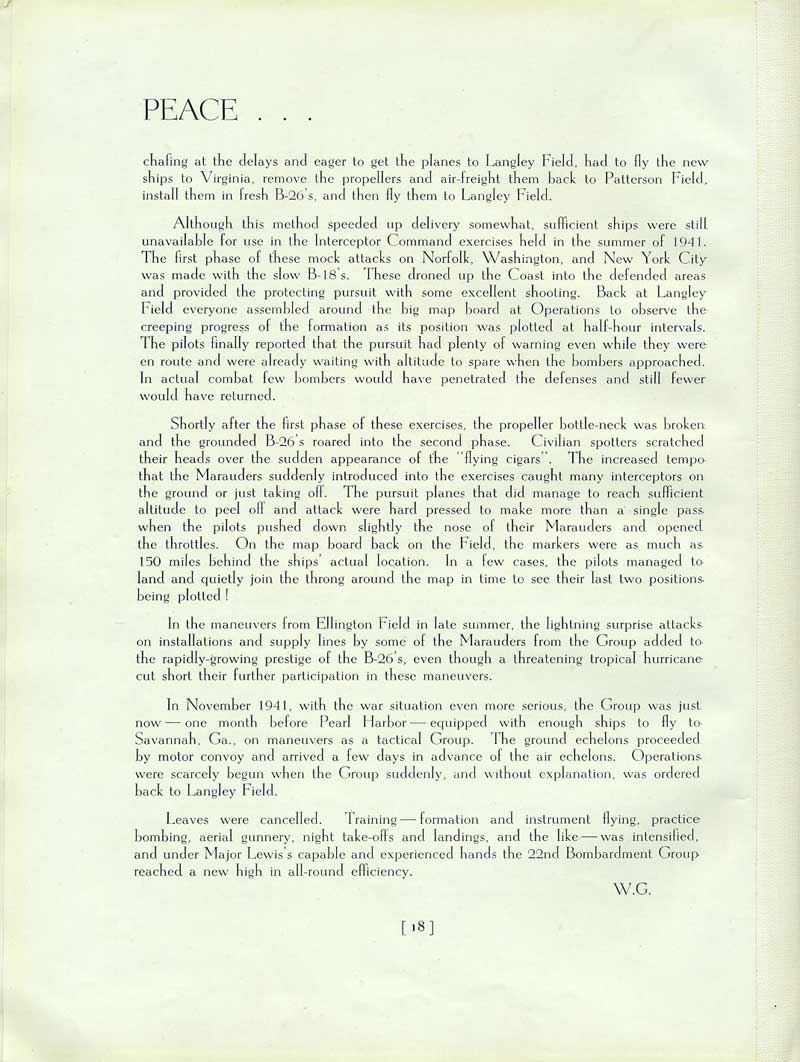
Next page...

| PEACE ... chafing at the delays and eager to get the planes to Langley Field, had to fly the new ships to Virginia, remove the propellers and air-freight them back to Patterson Field, install them in fresh B-26's, and then fly them to Langley Field. Although this method speeded up delivery somewhat, sufficient ships were still unavailable for use in the Interceptor Command exercises held in the summer of 1941. The first phase of these mock attacks on Norfolk, Washington, and New York City was made with the slow B-18's. These droned up the Coast into the defended areas and provided the protecting pursuit with some excellent shooting. Back at Langley Field everyone assembled around the big map board at Operations to observe the creeping progress of the formation as its position was plotted at half-hour intervals. The pilots finally reported that the pursuit had plenty of warning even while they were en route and were already waiting with altitude to spare when the bombers approached. In actual combat few bombers would have penetrated the defenses and still fewer would have returned. Shortly after the first phase of these exercises, the propeller bottle-neck was broken and the grounded B-26's roared into the second phase. Civilian spotters scratched their heads over the sudden appearance of the "flying cigars". The increased tempo that the Marauders suddenly introduced into the exercises caught many interceptors on the ground or just taking off. The pursuit planes that did manage to reach sufficient altitude to peel off and attack were hard pressed to make more than a single pass, when the pilots pushed down slightly the nose of their Marauders and opened the throttles. On the map board back on the Field, the markers were as much as. 150 miles behind the ships' actual location. In a few cases, the pilots managed to land and quietly join the throng around the map in time to see their last two positions being plotted! In the maneuvers from Ellington Field in late summer, the lightning surprise attacks on installations and supply lines by some of the Marauders from the Group added to the rapidly-growing prestige of the B-26's, even though a threatening tropical hurricane cut short their further participation in these maneuvers. In November 1941, with the war situation even more serious, the Group was just. now-one month before Pearl Harbor-equipped with enough ships to fly to Savannah, Ga., on maneuvers as a tactical Group. The ground echelons proceeded by motor convoy and arrived a few days in advance of the air echelons. Operations. were scarcely begun when the Group suddenly, and without explanation, was ordered back to Langley Field. Leaves were cancelled. Training-formation and instrument flying, practice bombing, aerial gunnery, night take-offs and landings, and the like-was intensified, and under Major Lewis's capable and experienced hands the 22nd Bombardment Group reached a new high in all-round efficiency. W.G. |